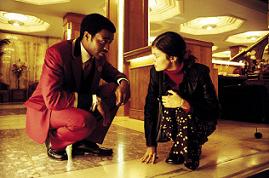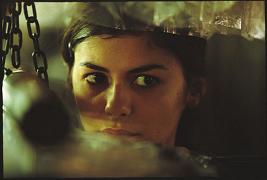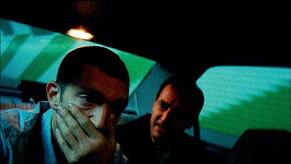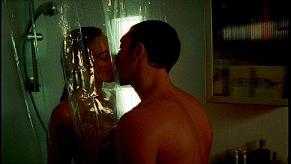Pistol Opera
In writing about this film, I feel like a carnival barker: Yes, folks, step right up to witness the death throes of one of cinema's most idiosyncratic talents! Right here on this very stage, you will be amazed as Seijun Suzuki pisses away his critical reputation in a haze of color and incoherence! Thrill as the film seems to evaporate before your very eyes! Gasp at the total lack of any character development or emotional resonance whatsoever! Groan as you realize this thing goes on at least 45 minutes longer than the material and inspiration will allow! Yes, folks, come be a witness to a restless mind gone supernova!
That's not to say that the other Suzuki films I've seen have been models of restraint and narrative economy. But at least "Tokyo Drifter" and "Branded to Kill" (of which "Pistol Opera" is a loose remake) had a bare minimum of structure and sense attached, the vestigal remnants of assembly-line scripts from the Nikkatsu Studio mill. Here, out on his own and directing for the first time in nearly ten years, Suzuki has pitched headlong into total style at the expense of everything else that makes a film work. The result is a pile of gibberish, a "Lisztomania" for the Hong-Kong-action-movie crowd.
The plot -- or what remains of it, anyway -- involves the adventures of the No. 3 assassin for the Assassin's Guild, a young woman named Stray Cat. For the reason that there wouldn't be a movie otherwise, the Guild has started to collapse, and Stray Cat's latest assignment is to take out Hundred Eyes, the No. 1 assassin. But there's other killers in her way as well, which means that every fifteen minutes or so Suzuki can throw in an artfully composed death scene. And make no mistake, the film is often beautiful to look at. Early on, I thought I may have been watching the director's best film yet. The battle between Stray Cat and Teacher (a surly assassin in a wheelchair who goes out rolling into the ocean) is eye-popping and fantastic and funny as hell. But the longer the film goes and the more obvious it becomes that there's nobody driving this engine, Suzuki's constant visual gimmickry becomes tiresome. His earlier works seemed spawned out of a post-war disenfranchisement and disconnection with society at large; without these melancholy underpinnings, it's like watching the world's longest fashion-magazine photo shoot -- sure, it's gorgeous, but what's the point?
What's worse, Suzuki seems to have lost his sense of humor with age. "Branded" and "Drifter" were heavily stylized and oft-nonsensical, true, but they also had a absurd wit about them -- it felt like Suzuki was getting away with something and was flaunting it at every opportunity. "Pistol Opera", though, treats the latter word in that title as a mandate. Slow and strangely somber most of the time, this is Art Gone Bad. The final fifteen minutes in particular, which theoretically contain the showdown between Stray Cat and Hundred Eyes, is a banal barrage of stagy and pretentious imagery. People are dressed in kimonos and there's naked painted dancing people in the midst of it all and the colored-backdrop trick is used again and again (probably because it was so effective in "Tokyo Drifter") and it's all so fucking capital-A-artsy that you just want to choke. "Branded to Kill" ended with the haunting sight of a possibly insane Hanada screaming "I am the No. 1 killer!" over and over; this has naked painted dancing people. As much as it pains me, it appears that Suzuki has nothing left to say. Lacking substance, his film drowns in hollow formalism. Let us hope that he does not see fit to sully his name further.
Question of the Week
Well, I haven't had much to add lately. The only movie I've seen in the past week is SWAT (my quick review: decent, if not especially original, action movie with a fair amount of humor; shut of phyrephox, :)), and I've actually spent most of the last two weeks watching Once and Again and Farscape (DVD sets of serialized shows are so addicting). But lucky for me, it's time for a new "Question of the Week."
Here's the game we will be playing, it's kind of like Telephone. We're going to take a movie or television show: the first person who posts can pick any one cast or crew member from that movie or television show, and then write a mini-review (one comments section long) of what they regard as that person's best work. The second person who posts will then pick a cast or crew member from the movie/TV show chosen by the first poster, and write their own mini-review of that person's best work....However, once a person or a particular movie/television show have been picked, subsequent posters can no longer use those options. The chain will go on as long as possible. The movie that will begin the game is:
SWAT (I've added a link to the IMDB.com for anyone who is not familiar with the movie).
As always, the question of the week is open to all blog members and readers. Feel free to respond.
Dirty Pretty Things
Screenwriter Steve Knight tugs mightily at the heartstrings in Dirty Pretty Things, Stephen Frear’s new movie about the dark side of the lives of London immigrants, but both Knight and Frear stack the deck so strongly to the advantage of the poor immigrants that sympathetic emotion is nearly negated. A strong, multi-ethnic ensemble cast helps give the London dregs some character, but with the benefit of a strong cast comes the unfortunate side effect of a group of down-and-outs who seem like they should be living it up.  Chiwetel Ejiofor plays an illegal immigrant who fled Nigeria to work a day shift as a cab driver and the night shift at the shady Baltic Hotel, where he meets a maid (Audrey Tautou) who is working there illegally while trying to attain citizenship. With these two in tow, together with a kind and beautiful whore (Sophie Okonedo), a generous, pessimistic mortician (Benedict Wong) and an amusingly cynical Russian doorman (Zlatko Buric), Dirty Pretty Things has an ensemble cast full of resolute, intelligent, warm-hearted, interesting, note-worthy immigrants who have no problem forging bonds of, at the very least, shared comradery, but usually rich friendships and mutual love interests as well. Set against these attractive, individual faces are the bland and ruthless individuals trying to keep such immigrants in their place: Sergei Lopez, channeling a sinister, one note Anthony LaPaglia, plays the manager of the Baltic who arranges blackmarket surgeries in his hotel (among other things), the Gestapo-esque immigrant police, and a sweatshop owner who trades silence for sexual favors.
Much to the film’s tonal detriment, master cinematographer Chris Menges and hit-and-miss veteran English director Stephen Frears do little to make the London of Dirty Pretty Things seem  unusually dangerous, seedy, or containing for its character who should have to constantly look over their shoulders to make sure they aren’t going to be sent back from whilst they came. In fact, if one took away the seedy aspects of the plot, Menges’ expert lighting and Frear’s interesting backstreet locals could almost be deemed overly attractive. With little in the way of atmospheric barriers to stop the immigrants from their dreams, and only a couple over-confident managerial exploiters and stupid cops on their tales, Tautou, with her endless beauty and resolute character, and Ejiofor with his lethargic handsomeness and self-containment, have a comfortable space in which to fall in love and find a way out of their cycle of oppression. Aided by their fellow immigrant friends (all immigrants are friends in this movie), Ejiofor and Tautou enact revenge on their exploiters and then escape to freedom with remarkable ease. If every illegal immigrant in every city were as charismatic, cunning, and bright as Dirty Pretty Things suggests (and every jerk looking for a blackmarket kidney or quick blowjob were as easy to rebuke), there would be a lot fewer problems in the world. More tension and less genre is needed in this stylized, well acted, but misguided little picture.
Irreversible
Gasper Noé’s Irréversible doesn’t so much instantly grab you by the throat so much as punch you in the face, leaving your bludgeoned, disoriented and a little queasy, the first sequence forcing one to immediately face the film’s extreme stylization: the camera swoops and swivels in the most unnatural and nausea inducing of axis, all the while the soundtrack is filled with what sounds like low frequency feedback and ambient static. It is not only a perfect mood setter for the following hour or so of one of the most upsetting viewings in years, but the hyper-stylized first scene of the film also hints at the kind of deconstructive cinematic ideas Noé is working at. Irréversible actually opens with the end credits scrolling backwards and follows them with the swirling, disorientating first scene, telling the story backwards like Memento but with a firm purpose in mind. The film then develops through roughly 10 minute long sections that are slyly edited to look like single takes (and many of them are). With chaotic mise-en-scene, unsettling content, and several interesting ideas behind all the style, Irréversible packs a wallop that amounts to more than its extreme brutality.
To most, the way Noé stylizes and structures his film will either be secondary to-or a gimmick complimenting-Irréversible’s controversial plotline. After a brief philosophical comment from a sideliner-  “Time destroys all things”-the film’s non-committal camera follows Marcus (Vincent Cassel) as he descends into a gay club called The Rectum. Traveling through deep-red corridors and finding nothing but the most extreme of graphic homosexual behavior, Marcus finds himself in a homophobe’s hell, feverishly trying to hunt down a man hiding in the club. With Marcus is his more timid friend Pierre (Albert Dupontel), but as Marcus goes deeper and deeper into the club, and as the atmosphere gets more claustrophobic and unnervingly sexually explicit, Marcus leaves Pierre behind in his fervor. Finally finding his man, Marcus picks a fight and ends up with a broken arm. To his rescue comes Pierre, who knocks Marcus’ victim down to the floor and precedes to beat him to death with a fire-extinguisher, repeatedly bashing the man’s face in until it is nothing but a quivering hunk of indistinguishable meat. In what looks like (but cleverly is not) one single shot Noé builds the cumulative effect of a descension into hell. It leaves one gasping for air, and all the more wary because Irréversible is infamous not for this beating, but for another sequence altogether.
The Rectum scene raises all the questions that the next hour and a half will resolutely not answer. Understandably the audience has probably already judged the film’s two main characters as violent, irrational and immensely dislikable; but Noé questions if immediate judgment is possible when all that is visible is that act and not the motivation, for it comes to light later that Marcus went to The Rectum because he was searching for the  man who raped and beat his girlfriend Alex (Cassell’s real-life wife, Monica Belucci) until she was in a coma. Does this make Marcus’ revenge right, or at least understandable? Even later it is revealed that Pierre and Marcus targeted the wrong man, but they think they got the right one. In the first conversation in the film a character philosophizes about a crime he was put away for-how it felt great for him to do it, but the authorities said it was wrong-he then concludes that there are no bad deeds, just deeds. This is at the crux of Irréversible, but not so much as a theory to be applied to the real world as it is to cinema. Although the film’s backwards structure initially feels like a gimmick, there is a correlative strategy between Irréversible’s narrative and its structure; it is there to constantly question what the audience thinks and feels about the people on screen. For example, the cornerstone of the film, the infamous single-take rape of Alex, is the first time the audience gets to look at Monica Bellucci. And yet the film never lets the audience identify with Alex as a character nor with Bellucci as a star in the normal sense of the word, merely as an object representing “woman”-Noé purposely shoots the entire scene so that one can never fully see Bellucci-first his camera follows her from behind, then the rapist covers her face to keep her from screaming, and by the end she is so beaten that she cannot be recognized. This is a prime example of Noé’s formal strategy. Besides for asking questions about justifying isolated character actions, Noé is also reflecting on what it takes for the audience to be affected by cinema, how characters and plot events can be combined or isolated and how that can impact a film’s emotional punch. To say that Noé’s film is devastating would be an understatement, but the heart of the matter is why it is so wrenching, what about the way the characters and their formal depiction are represented in film is so affecting.
Irréversible's narrative is admittedly simple once one subtracts its formalism, for Noé is more interested in what his technique can bring to the most basic of material. A strong instance of this is the third level to the film’s backwards structure, an odd combination of stylistic regression and narrative contrivance. As the film steps backwards away from the rape Noé’s camera calms down significantly.  Each sequence is still shot in the single-take fashion, but gone is the gyrating camera, gone is much of the disturbing low frequency noise on the soundtrack, and in their place are far more “normal” compositions of Pierre, Alex, and Marcus chatting. Be it an extended, improvised chat about sex on the subway or the couple’s warm bedroom banter, Noé sedates his style in direct proportion to each scene’s narrative distance from film’s violent first half. Similarly, Noé begins to coat his characters in a sickly sweet gloss that undercuts the brutal, gritty, impressionistic realism of the film’s first half. Marcus and Alex’s relationship regresses from argument to naïve heterosexual perfection, even hinting at the possibility of Alex being pregnant. (There is a strong juxtaposition of the film’s beginning and end, where, respectively, there is the picture perfect ideal of a heterosexual relationship, and then the most degenerate, graphic and disturbing portrayal of homosexual relationships.) Boy loves girl, boy fights with girl, girl gets raped, boy enacts right of vengeance is all but the most exploitive plotline possible, but what Noé does with it is truly remarkable. The film is short, a quick uppercut to the jaw and its over, the darkness fading, and the camera sinking lovingly into Bellucci’s gorgeous summertime glow. But the dreadfulness of the experience remains, as do Noé’s many questions, the prime one being-should I really be talking about formal technique, or am I covering up for the pure visceral quality of the movie’s primeval violence?
|

